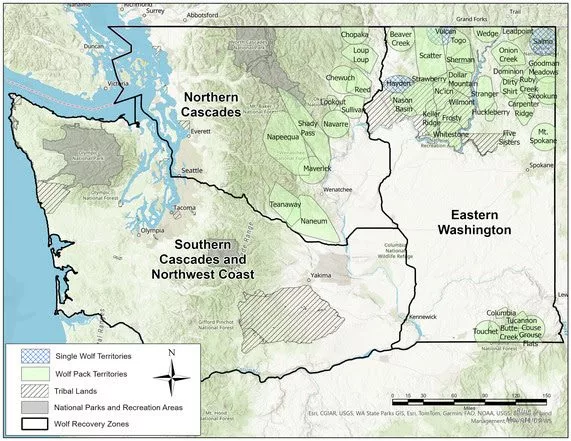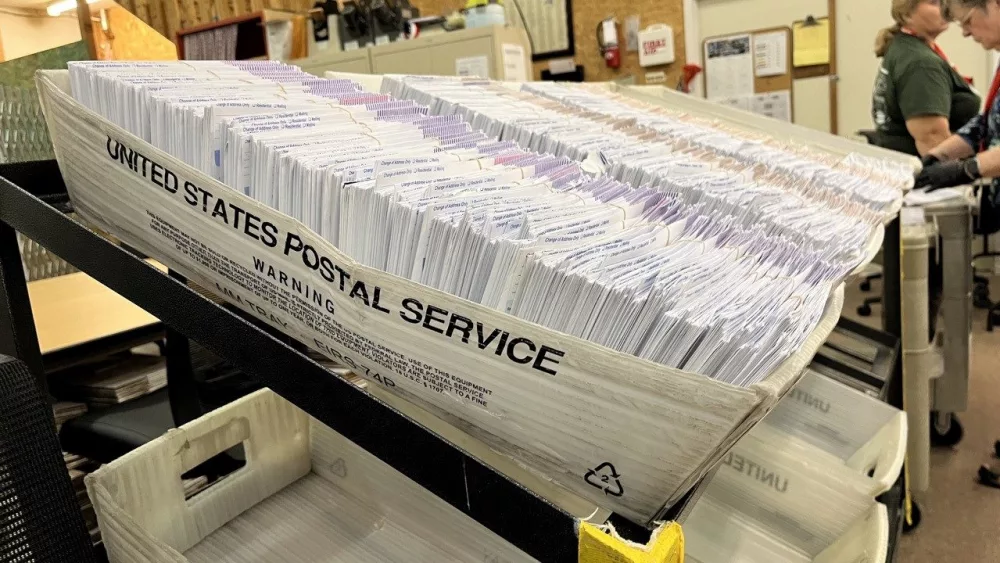OLYMPIA, WA – The number of gray wolf packs in Washington increased slightly in 2024, according to the Washington Gray Wolf Conservation and Management 2024 Annual Report, released today by the Washington Department of Fish and Wildlife (WDFW) while the state’s wolf count declined overall. Based on wolf biology and long-term population trajectory, WDFW wolf biologists do not believe wolf recovery is threatened at this time.
“The state’s wolf population grew by an average of 20% per year since the first WDFW wolf survey in 2008, until 2024,” said WDFW Statewide Wolf Specialist Ben Maletzke. “Despite reduced population counts statewide, the number of packs increased in the North Cascades in 2024, and both the North Cascades and Eastern Washington Recovery regions continued to meet or exceed recovery objectives for the fifth year in a row.”
As of Dec. 31, 2024, WDFW and partnering tribes counted 230 wolves (a 9% decrease from 2023) in 43 packs in Washington. Eighteen packs were successful breeding pairs. These numbers compare with 2023’s count of 254 wolves in 42 packs and 24 breeding pairs. WDFW counts wolves annually through activities like track, aerial, and camera surveys. As in past years, survey results represent minimum counts of wolves plus 12.5% for lone wolves and dispersers, due to the difficulty of counting every animal.
WDFW documented 37 wolf mortalities in 2024, including four removals in response to wolf-livestock conflict, 19 legally harvested by tribal hunters, and seven mortalities attributed to unlawful killing or poaching, among other causes of death. Charges have been referred to prosecutors for consideration in one of the unlawful take cases.
“Poaching wolves is unacceptable – in Washington, illegally killing a wolf or other endangered species is a gross misdemeanor, punishable by up to a $5,000 fine and one year in jail,” said WDFW Director Kelly Susewind. “In addition, poaching slows the natural recovery of wolves in the state and hinders their ability to reach recovery goals that could allow them to be delisted as a state-endangered species.”
Three of the four wolves that WDFW documented in the Southern Cascades and Northwest Coast wolf recovery region in recent years were killed illegally, and the presence of the fourth has not been documented in more than a year. That region is the only one of three that did not reach minimum recovery goals in 2024.
The Eastern Recovery region had 31 packs, 13 of which were considered successful breeding pairs, while the North Cascades recovery region had 12 packs, five of which were considered successful breeding pairs. To reach statewide recovery objectives, the Southern Cascades and Northwest Coast need a minimum of four successful breeding pairs while the other two regions maintain a minimum of four successful breeding pairs and at least six additional successful breeding pairs located anywhere in the state.
Other highlights from the Washington Gray Wolf Conservation and Management 2024 Annual Report include:
- Three new packs formed or re-established in 2024 including the Teanaway and Naneum packs in Kittitas County and the Reed pack in Okanogan County.
- Fifteen wolves (28% of the collared wolves monitored during the calendar year) were documented dispersing from their pack territories in 2024, while seven wolves (13% of the radio-collared wolves) dispersed out of Washington state.
- An error was made in the 2023 annual wolf report regarding the Strawberry pack, which resides primarily on Confederated Tribes of the Colville Reservations (CTCR) lands and is managed under tribal authority. Five wolves from that pack were harvested during 2023 that were not subtracted from the CTCR minimum count of eight. The year-end count for that pack should have been three rather than eight. That pack had also been noted as a breeding pair, but did not meet the criteria to be considered a breeding pair after these harvests were included. Correcting this error meant decreasing the overall minimum count from 260 to 254 (including 12.5% reduction of lone/dispersing wolves and number of successful breeding pairs by one to 24 successful breeding pairs in 2023. These numbers were corrected in the 2024 report.
WDFW documented 40 depredation events and confirmed that 17 cattle and one domestic dog were killed by wolves in 2024, while two calves were probably killed by wolves. Twenty-six cattle were confirmed injured by wolves, and 10 were probably injured by wolves. Up to 10 of the 43 (23%) known packs that existed in Washington during 2024 were involved in at least one confirmed or probable livestock injury or mortality. Seventy-seven percent of known packs were not involved in any known or probable livestock depredation even though many pack territories overlap various livestock operations. WDFW staff continued to work closely with livestock producers in 2024 to implement non-lethal conflict prevention measures.
Contributors to WDFW’s annual wolf report include the U.S. Fish and Wildlife Service, the National Park Service, the Spokane Tribe of Indians, Swinomish Tribe, Yakama Nation, and the Confederated Tribes of the Colville Reservation.
In addition to the Washington Gray Wolf Conservation and Management 2024 Annual Report, available on the Department’s website, a recording of today’s presentation of the report to the Fish and Wildlife Commission will be available on the website soon.
The Washington Department of Fish and Wildlife works to preserve, protect and perpetuate fish, wildlife and ecosystems while providing sustainable fish and wildlife recreational and commercial opportunities.





